The most recognized bee color is black and yellow, with stripes on the back. But different species of bees may be blue, white, orange, red and more! With over 20,000 bee species worldwide, there are a number of colors you may see in the wild.
Thousands of bee species exist around the globe, with North America having over 4,000 species. The diverse species of bees exhibit different colors and structures.
The most recognized bee color is black and yellow, with stripes on the back. Yellow and black are warning colors to keep enemies away from bees and their stingers.
Honey bees are just one type of bee, but other species of bees may be green, blue, orange, purple, grey, white, and pure black. While strips often identify bees, they can be solid, patterned, or metallic.
Within a hive of honey bees, bees may have variations in color, so some are lighter or darker or have more orange or cordovan red bodies.
Let’s explore the different bee colors, then focus on the honey bee’s colors.
Blue Colored Bees
There are different species of bluish-colored bees – 140 types in North America alone. Here, we describe a few that are common.
Blue Orchard Mason Bees, known as super pollinators, especially among blueberries, apples, plums, pears, almonds, and peaches, are native to North America. Rather than carrying pollen on their legs like honey bees, they carry it in their belly. They are called mason bees as they use clay to partition their nest rather than leaves. Metallic blue, they nest with their brood but live near other bees’ nests.
Blue Calamintha Bees (Osmia Calamintha), only found in Florida, are blue and white with slight traces of black. They only pollinate Ashe’s savory flower, a deciduous shrub, and are considered “critically imperiled” as human development, pesticides, and fires have limited their numbers.
Blue Carpenter Bees, native to Southeast Asia, India, and Southern China, are giant bright blue bees that live in wood such as dead trees, bamboo, or manmade structures rather than hives. They live with other related females (mothers, daughters, and sisters) and pollinate many flowers using buzz pollination.
Bright Metallic Blue Sweat Bees, often found in Texas, love the taste of salty human sweat. With a rock and roll-sounding name of Augochloropsis Metallica, they are bright blue metallic bees that may appear purple or green depending on the light.
Blue Banded Bees (Amegilla Cingulata) are solitary bees with a conspicuous blue-striped thorax. They are attracted to anything blue in color, including blue attire on humans, but favor blue and lavender crops. These bees are excellent pollinators in Australia, Malaysia, India, and Papua New Guinea. They are noted for using buzz pollination, whereby they beat their wings so rapidly that pollen shakes free and clings to the bee’s body. This method of pollination is more effective than the method honey bees use to collect loose pollen on their legs.
Neon Cuckoo Bees resemble blue-banded bees in appearance. They are Australian natives known for the blue fur on their faces, bodies, and legs and their bluish and blackish body color patterns. The bees’ wings are transparent with a shade of purple and brown. While intriguing, these bees are parasites who lay eggs in the nest of other bees and eat up the pollen after killing host bee larvae.
Blue Carpenter Bees are big (one inch), hairy, solitary bees in Southern China and India. Primarily found in nests, a queen bee can share a nest with another when she cannot find a good place to lay eggs.
The female blue carpenter bees have a stinger and are covered with dense pale blue fur giving them a noticeable blue coloration. The male bees do not have a stinger and have a green-brown shade.
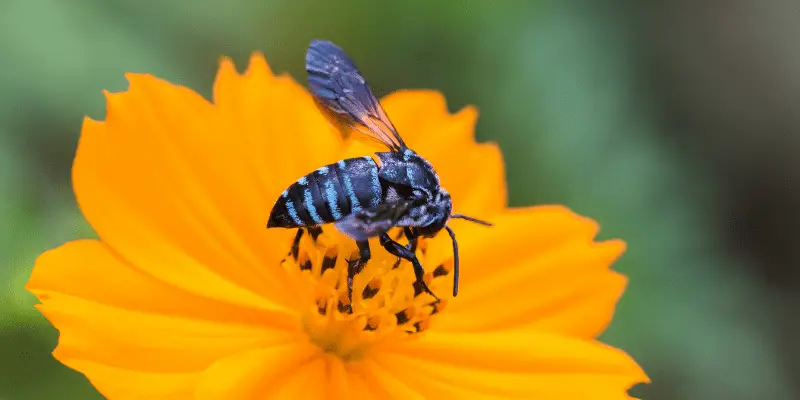
White Colored Bees
White bees are not albino bees because their color results from a genetic abnormality, not a lack of pigmentation. Most so-called white bees have strips of other colors along with black bodies.
White-banded Bees (Lasioglossum Halictinae) are native to Australia and are the most abundant bee in the world next to the commercial honey bee. As their name suggests, they are distinguished by white furry bands, but their bodies are brown or black. Their sting is powerful and is known to cause anaphylactic shock among those sensitive to bee stings. Click here to learn how to treat a bee sting.
White Digger Bees (Habropoda Apoidea) are usually found in North America, constructing individual nests close to each other but underground. Many of these bee species have yellow and white hair covering their whole body, while some also have black hair. They are fuzzy and resemble bumblebees. As they prefer cooler weather, they are often seen as adults in spring and survive the winter.
White Haired Bees are solitary bees, the most common bee in Texas. Like the cattle, the bees have long horns and thick white fur covering their black bodies to gather and carry large amounts during each trip. Unlike honey bees, these bees build their nests using soil-like materials. They are often confused with hornets due to their wasp-like bodies but are not as aggressive.
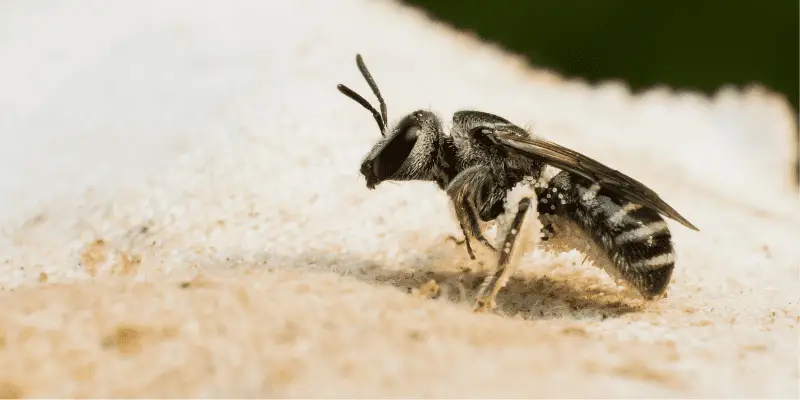
Orange Colored Bees
The are many varieties of orange bees, especially from the Euglossini tribe, who are more commonly known as orchid bees.
Orange Orchid Bees (Euglossa hansoni) is a diverse type of bees common in the US and South America, numbering 200 co-species and growing. They come in many colors, including orange, and are chromic so that they change colors from green to bright orange. While the females busy themselves with pollination and nest building, the males fly up to 30 miles per trip to collect scents that may help them attract mates.
Orange Belted Bumblebees (Bombus ternarius) are queens, and workers have an orange thorax and yellow fur atop blackheads, while the males have orange straps and black hair on yellow faces. The females can sting multiple times if threatened as they support the larvae, seek food sources, and maintain the nesting site.
Teddy Bear Bees (Amegilla bombiformis), or golden-haired mortar bees, are native to Australia,
Their bodies are covered with orange-brown hair except for the abdomen. The bees look purely orange in bright environments instead of a golden color. While they are plump like bumblebees, they are from a different genus. Unlike most bees, their nests do not have hexagonal-shaped cells but opt for urn-shaped ones.
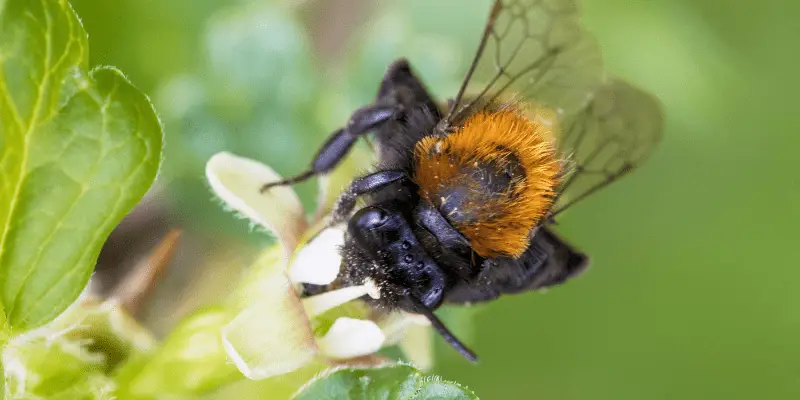
Red Colored Bees
Red-colored bees are rare in the United States, but they exist worldwide.
Red-tailed Bees (Bombus Lapidarius) are found in Central Europe. With a distinctive black and red body, these bumblebees are social and outstanding pollinators with a good-sized proboscis. Worker females and the queen look similar, except the queen is much larger than the worker females. Males typically have red and black coloration, a yellow band around the abdomen, and yellow facial markings. They are active in June, July, and August and dwell in small colonies of up to a few hundred bees.
Red Mason Bees are solitary bees occupying their nest in the crumbling mortar of old buildings, hollow plant stems, and holes in cliffs. They are gingery in color, and the male has a tuft of white hair on his face. Native to England and Wales, this bee is active from March through June.
Red Dwarf Honey Bees (Apis florea) are small bees native to Australia with reddish-brown upper abdomens, black and white banded lower abdomens, and black and white heads and thoraxes. They nest in single combs suspended from low tree branches shaded by vegetation.
The female bees have red body with orange hair on their tail. The male bees have yellow hair on their tail and a yellow stripe on the thorax and head.
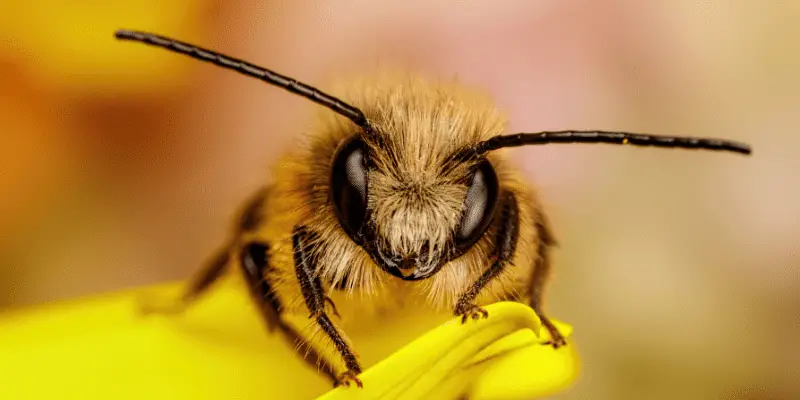
Additional Bee Colors
Bee colors also include:
- Black-colored bees – Large Arabian Carpenter Bee and Ashy Mining Bee.
- Yellow-colored bees – Yellow-Faced Bee, Digger Bees, Small Mining Bee, and Leafcutter Bees.
- Green-colored bees – Metallic Green Sweat Bee and Green Orchid Bee.
- Purple-colored Bee – Purple Carpenter Bee.
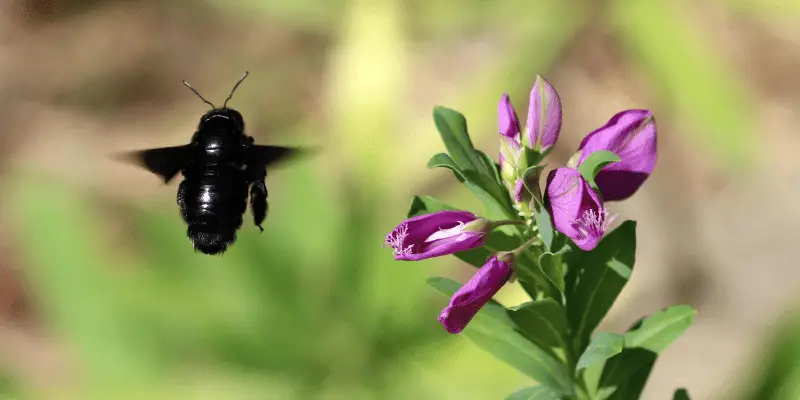
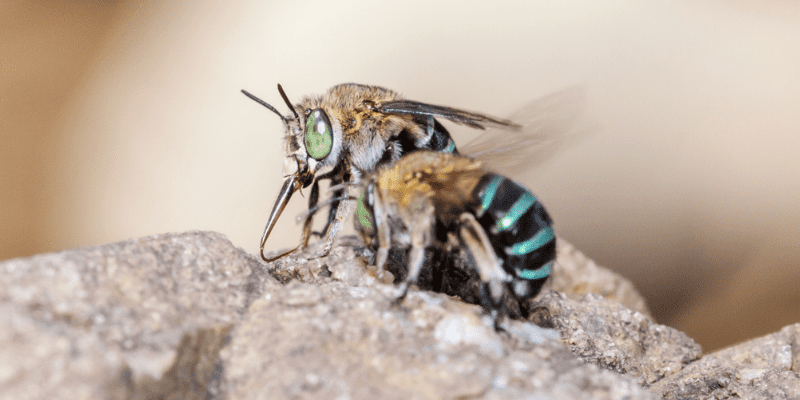
Honey Bee Colors (Apis Mellifera)
A beekeeper can be surprised to open a new colony beehive and notice different-colored worker bees. But, it is normal and healthy for worker bees from the same beehive to comprise light and dark colors. The varying shades between brown, golden, and yellow colors display the gene diversity of the drones mated with the queen honey bee.
The brightness or darkness of honey bees can provide clues regarding their origin. A light-colored worker bee with bright yellow colors is likely to have Italian honey bee ancestry. In contrast, darker bees could either have Carniolans or Russian genes.
Most beekeepers prefer dark-colored bees because they are sturdy during winter and quickly rebuild their colonies in spring. Also, beekeepers create hybrid species such as the Africanized honey bees to develop resistance to parasites, diseases, and climate.
Honey Bees That Change Color
Honey bee colonies remain with their original color throughout their lifespan. However, the worker bee’s appearance changes over time, and it may look like they have a different body color. Worker bees lose their fur when working away from the beehive, changing their looks but not their color.
Nevertheless, beekeepers should be on the lookout for gleaming black oily bees. Some viruses cause such an appearance.


